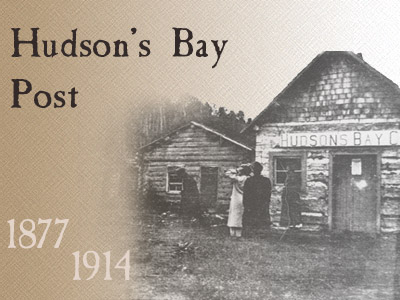|
|
Raynor Whitely Describes the Flood of 1904 |
|
|
Raynor Whitely Rides to Edmonton to Report the Flood |

In the 1870s, the pack route between the Hudson's Bay Company (HBC) posts at Fort Edmonton and Fort Assiniboine — the main trade route to Lesser Slave Lake, the Peace River district, and the interior of British Columbia — often became impassable because of mud and swollen rivers. In hopes of finding an alternate route to send its goods north, in the spring of 1874 the Hudson's Bay Company sent a scout to survey the terrain from Fort Edmonton to the south loop of the Athabasca River and the idea of Athabasca Landing was born.
Throughout the summer of 1876, a freight trail 100 miles long — the Landing Trail — was completed between Fort Edmonton and "the elbow" of the Athabasca River. Supplies were brought north by cart in the summer and by sleigh in the winter. The greatest activity at the Landing in the 1870s occurred in spring when the HBC would dispatch a clerk from Fort Edmonton to hire Métis labourers to construct a fleet of scows to ship supplies to Lesser Slave Lake and posts beyond. In 1877 the Company constructed a 20-ft. X 36-ft. log shed at Athabasca Landing to store supplies and furs en route to other posts.
An immediate stimulus to the Landing Trail and Athabasca Landing came about in the early 1880s when the HBC abandoned its old routes, such as the Methye portage, and decided to ship trade-goods and furs out of the north-west via steamboats. Henceforth the Athabasca River became "not only the HBC's main route to Lesser Slave Lake and the Peace River country but also to Lake Athabasca, Great Slave Lake, and the Mackenzie valley."
In 1882 when the Company sent its first cargo by scow to Fort McMurray, it was not known what difficulty a series of rapids on the Athabasca would pose. A contingent of Indians and Métis boatmen portaged the cargoes around the Grand Rapids via Grand Rapids Island, and "eased the lightened vessels through rocks and white water." Later, Métis boat handler Louis Fousseneuve set out to prove that "laden flatbottomed scows" could run the Grand Rapids. He succeeded and earned the nickname "Captain Shot." From 1885 onwards, the Athabasca-Ft. McMurray route was "the main highway to the North."

Alberta During the Territorial Period (1870-1905) Adapted from Alberta:A New History By Palmer and Palmer.
Despite such activity, no people lived permanently at the Landing until 1884 when the "warehouse was upgraded into a trading post" and Leslie Wood, a Hudson's Bay employee, became the first permanent resident of Athabasca Landing. He was a very trustworthy worker, as Chief Hardisty wrote in a confidential report, “Wood . . . 10 years in the service . . . and, as he understands the Indian language, is very useful when sent out to trade in Indian camp. He is a pushing, energetic man, runs freight dept. and takes care of trading parties. He has been married 12 years. Good post manager." The HBC built a new dwelling house / workshop / freight warehouse at the site, and in the summer of 1888 built a steamboat at the Landing, the S.S. Athabasca, to ply the central section of the Athabasca River between Mirror Landing (near Lesser Slave Lake) and Pelican Portage.
By 1889, the Landing’s population would consist of five or six people who ran the HBC post (Leslie Wood and possibly his wife, the cook Lynn Short, and labourers George Guillon, William Gullion, and Thomas Mearon), eleven men who manned the steamboat, and independent store-keeper and fur-trader Richard Secord. There was no permanent Indian encampment at the Landing, but some native people would camp nearby when seasonal work was available. (Athabasca Historical Society 1986, 16-32)
![]()
Home | Hudson's Bay Company Post | The Landing Trail | Society, Gender, and Race | Transportation Hub | Boatbuilding | To the Klondike | The Commercial Boom | Amber Valley | The Athabasca Bore | Agriculture and Settlement | Then and Now